Attractions · Europe · Going Out · Italy · Regions · Western Europe
6 walled cities of Tuscany – with a great surprise at the end
Many luxury travelers have seen the major tourist cities in Italy such as Rome, Florence, and Venice. They have probably even visited the second-tier hot spots of Cinqueterre, the Amalfi Coast, and Sienna.
An area of Italy that is difficult to visit is Tuscany. Not because it is hard to find nor even hard to get to. But because it is so vast and there are hundreds of tiny pockets of Italian goodness. Point of fact: did you know that there are over 200 ancient walled cities in Tuscany? Most of the guidebooks take you through the same few towns and villages, so when you get there, they are packed with tourists.
Here, I will take you through several of these ancient towns and villages, beginning with the most common, and ending with a real surprise that is certainly off that beaten path. Along the way, take the time to enjoy some of the most excellent Tuscan wines from the Chianti region.
Siena
Siena is arguably the most famous walled city in Tuscany. As a UNESCO World Heritage site, it enjoys plenty of tourist traffic. This historically-charged city was created by the Etruscans, a pre-Roman culture that thrived from around 700 bce to approximately 400 bce when they were assimilated into the Roman population. The twice-annual horse race, the Palio, is held between neighborhoods (Contrade, pronounced con-TRAH-deh) to determine who gets to be the holder of the most coveted city prize as the top Contrade. The Sienna Cathedral is a medieval Church that will take your breath away. Inside you will find a Carrera marble pulpit along with fantastic works by some of the Renaissance Superstars such as Michelangelo and Donatello. A welcome feature within the Sienna Cathedral is the Piccolomini Library where you will be touched by the sweet images of Raphael in many of the paintings by Pinturicchio, who adored the looks of his most prized student.
 Also, a climb up the Torre del Mangia (seen below as a shadow) will gain you an overhead view of not only this captivating walled city but also you will feast your eyes on the surrounding farms and vineyards of the impressive Tuscan Countryside.
Cortona
Upon entering the mighty gates of Cortona, you will be greeted by a straight road heading uphill directly in front of you. A walk up this road will take you to a picturesque and beautiful piazza that you will not soon forget. Cortona is laced with fantastic stories of history that include an essential settlement for the ancient Etruscan people, a battle where the great Carthaginian General Hannibal laid waste to the Roman army during the second Punic War, and where you will enjoy some of the most exquisite food and drink offered in Tuscany.
Also, a climb up the Torre del Mangia (seen below as a shadow) will gain you an overhead view of not only this captivating walled city but also you will feast your eyes on the surrounding farms and vineyards of the impressive Tuscan Countryside.
Cortona
Upon entering the mighty gates of Cortona, you will be greeted by a straight road heading uphill directly in front of you. A walk up this road will take you to a picturesque and beautiful piazza that you will not soon forget. Cortona is laced with fantastic stories of history that include an essential settlement for the ancient Etruscan people, a battle where the great Carthaginian General Hannibal laid waste to the Roman army during the second Punic War, and where you will enjoy some of the most exquisite food and drink offered in Tuscany.
 From the wall’s edge, you will look down upon the Chiana Valley to see the enormous Chianina cattle grazing far below. A highlight in Cortona is the excellent Etruscan Academy Museum which displays exceptional examples of ancient pottery, tools, and items of everyday living in ancient times. Additionally, the museum features an Archaeological Park where you can walk Roman Roads, and visit old Etruscan Tombs. The Church of San Francesco boasts a cushion and a tunic said to have belonged to Saint Francis of Assisi. And the Diocesan Museum features paintings by the Renaissance giant, Fra Angelico.
San Gimignano
This picturesque medieval city, known locally as The City of Fine Towers, San Gimignano (pronounced san jim-ee-NYAH-no), is understandably a UNESCO World Heritage Site. Surrounded by three walls, this triangular city boasts 14 towers that were created by competitive neighbors. Near the end of the Renaissance period (the late 1500’s), there were as many as 72 tower houses making up the Gothic and Romanesque skyline. Today, the remaining 14 towers still lend to creating a photo-ready ornament on the horizon. A climb up some of these towers will gain you excellent views as you look down upon this 3-sided city, as well as the sweeping Tuscan countryside.
From the wall’s edge, you will look down upon the Chiana Valley to see the enormous Chianina cattle grazing far below. A highlight in Cortona is the excellent Etruscan Academy Museum which displays exceptional examples of ancient pottery, tools, and items of everyday living in ancient times. Additionally, the museum features an Archaeological Park where you can walk Roman Roads, and visit old Etruscan Tombs. The Church of San Francesco boasts a cushion and a tunic said to have belonged to Saint Francis of Assisi. And the Diocesan Museum features paintings by the Renaissance giant, Fra Angelico.
San Gimignano
This picturesque medieval city, known locally as The City of Fine Towers, San Gimignano (pronounced san jim-ee-NYAH-no), is understandably a UNESCO World Heritage Site. Surrounded by three walls, this triangular city boasts 14 towers that were created by competitive neighbors. Near the end of the Renaissance period (the late 1500’s), there were as many as 72 tower houses making up the Gothic and Romanesque skyline. Today, the remaining 14 towers still lend to creating a photo-ready ornament on the horizon. A climb up some of these towers will gain you excellent views as you look down upon this 3-sided city, as well as the sweeping Tuscan countryside.
 San Gimignano pays homage to Saint Fina (Serafina), and inside the Chapel of Santa Fina, you will find stunning frescos created by the Renaissance great Ghirlandaio, the Master instructor to the likes of Botticelli, Leonardo da Vinci, and Michelangelo. The two main piazzas are Piazza della Cisterna, recognizable by its triangular shape and a water cistern in its center, and Piazza Duomo. These piazzas are connected by an ancient tunnel which you much pass through to visit both areas. A main street attraction is the Museum of Torture where visitors are greeted by a seemingly endless wall of human skulls. The museum displays a variety of techniques used for torturing both criminals as well as those who possessed wanted information.
San Gimignano pays homage to Saint Fina (Serafina), and inside the Chapel of Santa Fina, you will find stunning frescos created by the Renaissance great Ghirlandaio, the Master instructor to the likes of Botticelli, Leonardo da Vinci, and Michelangelo. The two main piazzas are Piazza della Cisterna, recognizable by its triangular shape and a water cistern in its center, and Piazza Duomo. These piazzas are connected by an ancient tunnel which you much pass through to visit both areas. A main street attraction is the Museum of Torture where visitors are greeted by a seemingly endless wall of human skulls. The museum displays a variety of techniques used for torturing both criminals as well as those who possessed wanted information.
 Fiesole
For those staying in Florence for a few days, this is the answer to the perfect day trip: Fiesole (pronounced fee-eh-SOL-eh). Simply hop on the bus and go the short 7 miles up the hill. When the bus reaches the end of the line, disembark and look over the wall on the side of the street. Below, you will be treated to an excellent view of the city of Florence. If weather permits, this view is second to none! The medieval homes in the neighborhood will have you clicking away to get some beautiful selfies. When finished here, look behind you to the tall tower. Walk towards it; laid before you will be a stunning archaeological site of an ancient Roman Amphitheater!
Fiesole
For those staying in Florence for a few days, this is the answer to the perfect day trip: Fiesole (pronounced fee-eh-SOL-eh). Simply hop on the bus and go the short 7 miles up the hill. When the bus reaches the end of the line, disembark and look over the wall on the side of the street. Below, you will be treated to an excellent view of the city of Florence. If weather permits, this view is second to none! The medieval homes in the neighborhood will have you clicking away to get some beautiful selfies. When finished here, look behind you to the tall tower. Walk towards it; laid before you will be a stunning archaeological site of an ancient Roman Amphitheater!
 Buy a ticket and go down into it, and walk through and around it. The cool thing is that when the ancient Romans built this facility, they were actually covering up an even more ancient Etruscan site! The archaeologists did a fantastic job of exposing both cultures in this one incredible site. Apparently, the peace-minded Etruscans who lived in the area, were able to hold off the intruding Romans, until eventually succumbing in 90bc, and were either killed or were assimilated into the Roman culture.
Buy a ticket and go down into it, and walk through and around it. The cool thing is that when the ancient Romans built this facility, they were actually covering up an even more ancient Etruscan site! The archaeologists did a fantastic job of exposing both cultures in this one incredible site. Apparently, the peace-minded Etruscans who lived in the area, were able to hold off the intruding Romans, until eventually succumbing in 90bc, and were either killed or were assimilated into the Roman culture.
 The site museum is small but well worth taking time to visit. The objects that were unearthed in the dig site outside will amaze and even amuse you. You will learn more about the Etruscans who were the namesakes of ‘Tuscany.’ This is an A+ way to spend your day! Surrounding this hilltop treasure is a variety of villas inhabited for centuries by wealthy Florentines such as Lorenzo (the Magnificent) de’Medici.
Vertine
The tiny hilltop medieval walled city of Vertine (pronounced vayr-TEEN-eh) is the perfect place for those looking to get away from it all. This adorable little village is small enough to stroll around it’s walls in under an hour. Vertine was originally a castle built during the 11th century. A small village eventually grew around it that boasted 7 towers. Today only a single tower remains among the stone homes and shops. During the summer, much of the town is empty, as the home-owners commonly go away to their own summer homes for the season. If your goal is to find a place in Tuscany where you can live among the locals without the intrusion of touristic throngs, Vertine is the place. Use it as a base for wine tasting, as a short 10-20 minute drive in any direction will take you past many quaint and distinct wineries.
The site museum is small but well worth taking time to visit. The objects that were unearthed in the dig site outside will amaze and even amuse you. You will learn more about the Etruscans who were the namesakes of ‘Tuscany.’ This is an A+ way to spend your day! Surrounding this hilltop treasure is a variety of villas inhabited for centuries by wealthy Florentines such as Lorenzo (the Magnificent) de’Medici.
Vertine
The tiny hilltop medieval walled city of Vertine (pronounced vayr-TEEN-eh) is the perfect place for those looking to get away from it all. This adorable little village is small enough to stroll around it’s walls in under an hour. Vertine was originally a castle built during the 11th century. A small village eventually grew around it that boasted 7 towers. Today only a single tower remains among the stone homes and shops. During the summer, much of the town is empty, as the home-owners commonly go away to their own summer homes for the season. If your goal is to find a place in Tuscany where you can live among the locals without the intrusion of touristic throngs, Vertine is the place. Use it as a base for wine tasting, as a short 10-20 minute drive in any direction will take you past many quaint and distinct wineries.
 Chiusdino
In the title, I promised you a surprise at the end, and this is it: Chiusdino (pronounced kee-us-DEE-no). Why you ask? Read on. Chiusdino sits demurely atop a hill in the Province of Siena. This hilly little village is far from the tourist path, so it holds no popular shopping or tourist attractions. It is merely a warm and delicious local village, home to families that have lived there for centuries. Restaurants? You bet, and proud they are of their local cuisine. A stroll through the quiet streets will lead you to the city museum where you will find their ancient treasures and relics.
Chiusdino
In the title, I promised you a surprise at the end, and this is it: Chiusdino (pronounced kee-us-DEE-no). Why you ask? Read on. Chiusdino sits demurely atop a hill in the Province of Siena. This hilly little village is far from the tourist path, so it holds no popular shopping or tourist attractions. It is merely a warm and delicious local village, home to families that have lived there for centuries. Restaurants? You bet, and proud they are of their local cuisine. A stroll through the quiet streets will lead you to the city museum where you will find their ancient treasures and relics.
 The town idolizes Saint Galgano, which begins the ‘surprise’ portion of this article. Within the walls of the town itself is the Rectory of St. Michael the Archangel. And within the Rectory is the reliquary which holds the head of Saint Galgano. So, who is this Galgano guy?
Galgano Guidotti was a 12th-century fellow that led a barbarous life. In his later years, he had a vision of the Archangel Michael promising to personally protect him. And on another occasion, his horse led him to a spot where, in another vision, he met the twelve Apostles and the Creator himself. It was in this spot, near Chiusdino, where he took hold of his sword and jammed it into a rock. Witnesses were known to have said that ‘…the stone yielded like butter.’ And it was here that he swore to give up his evil-doing and become Pious, which eventually led to his Sainthood.
The town idolizes Saint Galgano, which begins the ‘surprise’ portion of this article. Within the walls of the town itself is the Rectory of St. Michael the Archangel. And within the Rectory is the reliquary which holds the head of Saint Galgano. So, who is this Galgano guy?
Galgano Guidotti was a 12th-century fellow that led a barbarous life. In his later years, he had a vision of the Archangel Michael promising to personally protect him. And on another occasion, his horse led him to a spot where, in another vision, he met the twelve Apostles and the Creator himself. It was in this spot, near Chiusdino, where he took hold of his sword and jammed it into a rock. Witnesses were known to have said that ‘…the stone yielded like butter.’ And it was here that he swore to give up his evil-doing and become Pious, which eventually led to his Sainthood.
 Since then, a fabulous Monastery was built that today is one of the most striking ancient sites you will see. Even though roofless, the San Galgano Monastery works so perfectly with the afternoon sun, that this would be an ideal place for a wedding. And right next door is the little round Abbey of San Galgano that was built around that Sword in the Stone. YES! This is the REAL original Sword in the Stone from the famous Legends of the Round Table. As it turns out, Galgano’s Italian sword was the inspiration for the English author, T.H. White, to pen the story stating that only a good guy, pure of heart, would be able to pull the sword from the stone.
Since then, a fabulous Monastery was built that today is one of the most striking ancient sites you will see. Even though roofless, the San Galgano Monastery works so perfectly with the afternoon sun, that this would be an ideal place for a wedding. And right next door is the little round Abbey of San Galgano that was built around that Sword in the Stone. YES! This is the REAL original Sword in the Stone from the famous Legends of the Round Table. As it turns out, Galgano’s Italian sword was the inspiration for the English author, T.H. White, to pen the story stating that only a good guy, pure of heart, would be able to pull the sword from the stone.
 Surprise!
Patty Civalleri is the Owner of ItalyTravelBooks.com. ItalyTravelBooks.com represents books for the hungry traveller that regular guidebooks don’t feed.
If you would like to be a guest blogger on A Luxury Travel Blog in order to raise your profile, please contact us.
Surprise!
Patty Civalleri is the Owner of ItalyTravelBooks.com. ItalyTravelBooks.com represents books for the hungry traveller that regular guidebooks don’t feed.
If you would like to be a guest blogger on A Luxury Travel Blog in order to raise your profile, please contact us.
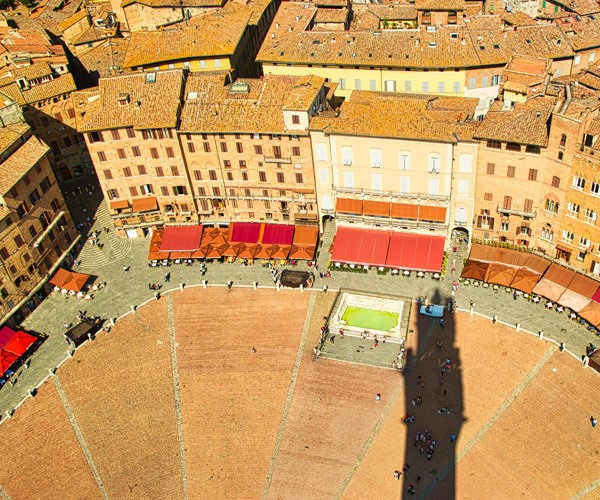 Also, a climb up the Torre del Mangia (seen below as a shadow) will gain you an overhead view of not only this captivating walled city but also you will feast your eyes on the surrounding farms and vineyards of the impressive Tuscan Countryside.
Cortona
Upon entering the mighty gates of Cortona, you will be greeted by a straight road heading uphill directly in front of you. A walk up this road will take you to a picturesque and beautiful piazza that you will not soon forget. Cortona is laced with fantastic stories of history that include an essential settlement for the ancient Etruscan people, a battle where the great Carthaginian General Hannibal laid waste to the Roman army during the second Punic War, and where you will enjoy some of the most exquisite food and drink offered in Tuscany.
Also, a climb up the Torre del Mangia (seen below as a shadow) will gain you an overhead view of not only this captivating walled city but also you will feast your eyes on the surrounding farms and vineyards of the impressive Tuscan Countryside.
Cortona
Upon entering the mighty gates of Cortona, you will be greeted by a straight road heading uphill directly in front of you. A walk up this road will take you to a picturesque and beautiful piazza that you will not soon forget. Cortona is laced with fantastic stories of history that include an essential settlement for the ancient Etruscan people, a battle where the great Carthaginian General Hannibal laid waste to the Roman army during the second Punic War, and where you will enjoy some of the most exquisite food and drink offered in Tuscany.
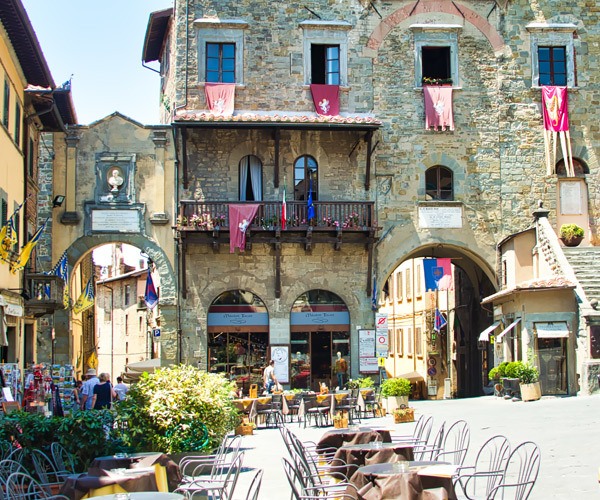 From the wall’s edge, you will look down upon the Chiana Valley to see the enormous Chianina cattle grazing far below. A highlight in Cortona is the excellent Etruscan Academy Museum which displays exceptional examples of ancient pottery, tools, and items of everyday living in ancient times. Additionally, the museum features an Archaeological Park where you can walk Roman Roads, and visit old Etruscan Tombs. The Church of San Francesco boasts a cushion and a tunic said to have belonged to Saint Francis of Assisi. And the Diocesan Museum features paintings by the Renaissance giant, Fra Angelico.
San Gimignano
This picturesque medieval city, known locally as The City of Fine Towers, San Gimignano (pronounced san jim-ee-NYAH-no), is understandably a UNESCO World Heritage Site. Surrounded by three walls, this triangular city boasts 14 towers that were created by competitive neighbors. Near the end of the Renaissance period (the late 1500’s), there were as many as 72 tower houses making up the Gothic and Romanesque skyline. Today, the remaining 14 towers still lend to creating a photo-ready ornament on the horizon. A climb up some of these towers will gain you excellent views as you look down upon this 3-sided city, as well as the sweeping Tuscan countryside.
From the wall’s edge, you will look down upon the Chiana Valley to see the enormous Chianina cattle grazing far below. A highlight in Cortona is the excellent Etruscan Academy Museum which displays exceptional examples of ancient pottery, tools, and items of everyday living in ancient times. Additionally, the museum features an Archaeological Park where you can walk Roman Roads, and visit old Etruscan Tombs. The Church of San Francesco boasts a cushion and a tunic said to have belonged to Saint Francis of Assisi. And the Diocesan Museum features paintings by the Renaissance giant, Fra Angelico.
San Gimignano
This picturesque medieval city, known locally as The City of Fine Towers, San Gimignano (pronounced san jim-ee-NYAH-no), is understandably a UNESCO World Heritage Site. Surrounded by three walls, this triangular city boasts 14 towers that were created by competitive neighbors. Near the end of the Renaissance period (the late 1500’s), there were as many as 72 tower houses making up the Gothic and Romanesque skyline. Today, the remaining 14 towers still lend to creating a photo-ready ornament on the horizon. A climb up some of these towers will gain you excellent views as you look down upon this 3-sided city, as well as the sweeping Tuscan countryside.
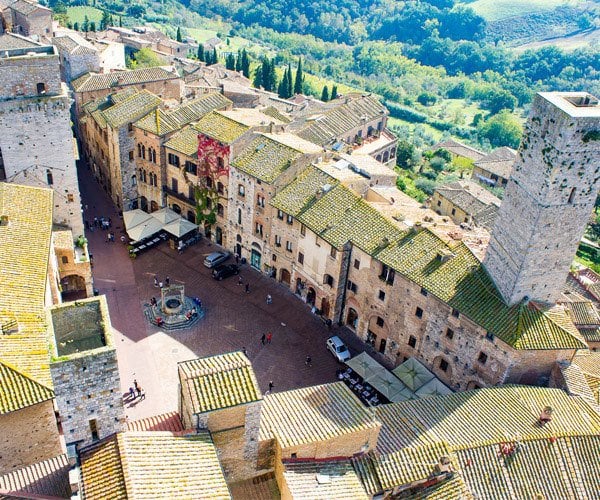 San Gimignano pays homage to Saint Fina (Serafina), and inside the Chapel of Santa Fina, you will find stunning frescos created by the Renaissance great Ghirlandaio, the Master instructor to the likes of Botticelli, Leonardo da Vinci, and Michelangelo. The two main piazzas are Piazza della Cisterna, recognizable by its triangular shape and a water cistern in its center, and Piazza Duomo. These piazzas are connected by an ancient tunnel which you much pass through to visit both areas. A main street attraction is the Museum of Torture where visitors are greeted by a seemingly endless wall of human skulls. The museum displays a variety of techniques used for torturing both criminals as well as those who possessed wanted information.
San Gimignano pays homage to Saint Fina (Serafina), and inside the Chapel of Santa Fina, you will find stunning frescos created by the Renaissance great Ghirlandaio, the Master instructor to the likes of Botticelli, Leonardo da Vinci, and Michelangelo. The two main piazzas are Piazza della Cisterna, recognizable by its triangular shape and a water cistern in its center, and Piazza Duomo. These piazzas are connected by an ancient tunnel which you much pass through to visit both areas. A main street attraction is the Museum of Torture where visitors are greeted by a seemingly endless wall of human skulls. The museum displays a variety of techniques used for torturing both criminals as well as those who possessed wanted information.
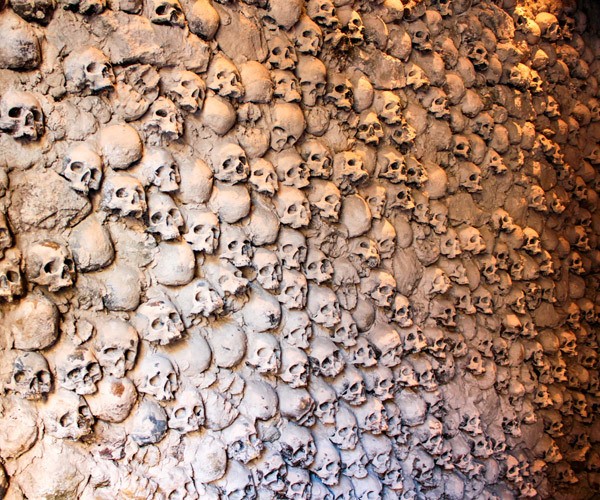 Fiesole
For those staying in Florence for a few days, this is the answer to the perfect day trip: Fiesole (pronounced fee-eh-SOL-eh). Simply hop on the bus and go the short 7 miles up the hill. When the bus reaches the end of the line, disembark and look over the wall on the side of the street. Below, you will be treated to an excellent view of the city of Florence. If weather permits, this view is second to none! The medieval homes in the neighborhood will have you clicking away to get some beautiful selfies. When finished here, look behind you to the tall tower. Walk towards it; laid before you will be a stunning archaeological site of an ancient Roman Amphitheater!
Fiesole
For those staying in Florence for a few days, this is the answer to the perfect day trip: Fiesole (pronounced fee-eh-SOL-eh). Simply hop on the bus and go the short 7 miles up the hill. When the bus reaches the end of the line, disembark and look over the wall on the side of the street. Below, you will be treated to an excellent view of the city of Florence. If weather permits, this view is second to none! The medieval homes in the neighborhood will have you clicking away to get some beautiful selfies. When finished here, look behind you to the tall tower. Walk towards it; laid before you will be a stunning archaeological site of an ancient Roman Amphitheater!
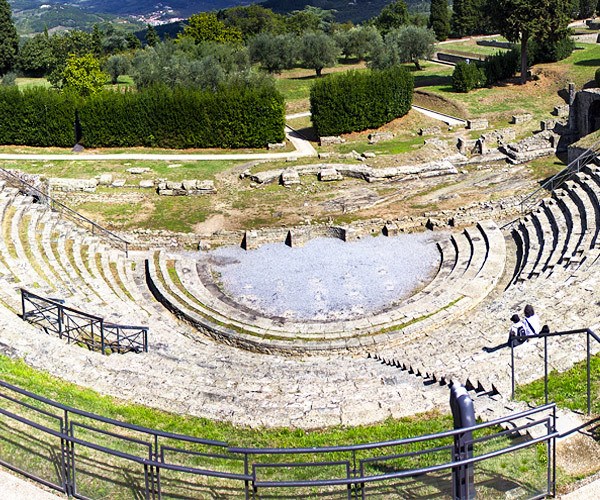 Buy a ticket and go down into it, and walk through and around it. The cool thing is that when the ancient Romans built this facility, they were actually covering up an even more ancient Etruscan site! The archaeologists did a fantastic job of exposing both cultures in this one incredible site. Apparently, the peace-minded Etruscans who lived in the area, were able to hold off the intruding Romans, until eventually succumbing in 90bc, and were either killed or were assimilated into the Roman culture.
Buy a ticket and go down into it, and walk through and around it. The cool thing is that when the ancient Romans built this facility, they were actually covering up an even more ancient Etruscan site! The archaeologists did a fantastic job of exposing both cultures in this one incredible site. Apparently, the peace-minded Etruscans who lived in the area, were able to hold off the intruding Romans, until eventually succumbing in 90bc, and were either killed or were assimilated into the Roman culture.
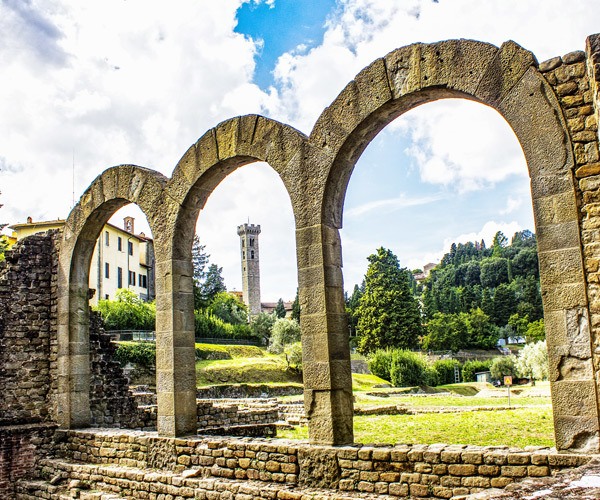 The site museum is small but well worth taking time to visit. The objects that were unearthed in the dig site outside will amaze and even amuse you. You will learn more about the Etruscans who were the namesakes of ‘Tuscany.’ This is an A+ way to spend your day! Surrounding this hilltop treasure is a variety of villas inhabited for centuries by wealthy Florentines such as Lorenzo (the Magnificent) de’Medici.
Vertine
The tiny hilltop medieval walled city of Vertine (pronounced vayr-TEEN-eh) is the perfect place for those looking to get away from it all. This adorable little village is small enough to stroll around it’s walls in under an hour. Vertine was originally a castle built during the 11th century. A small village eventually grew around it that boasted 7 towers. Today only a single tower remains among the stone homes and shops. During the summer, much of the town is empty, as the home-owners commonly go away to their own summer homes for the season. If your goal is to find a place in Tuscany where you can live among the locals without the intrusion of touristic throngs, Vertine is the place. Use it as a base for wine tasting, as a short 10-20 minute drive in any direction will take you past many quaint and distinct wineries.
The site museum is small but well worth taking time to visit. The objects that were unearthed in the dig site outside will amaze and even amuse you. You will learn more about the Etruscans who were the namesakes of ‘Tuscany.’ This is an A+ way to spend your day! Surrounding this hilltop treasure is a variety of villas inhabited for centuries by wealthy Florentines such as Lorenzo (the Magnificent) de’Medici.
Vertine
The tiny hilltop medieval walled city of Vertine (pronounced vayr-TEEN-eh) is the perfect place for those looking to get away from it all. This adorable little village is small enough to stroll around it’s walls in under an hour. Vertine was originally a castle built during the 11th century. A small village eventually grew around it that boasted 7 towers. Today only a single tower remains among the stone homes and shops. During the summer, much of the town is empty, as the home-owners commonly go away to their own summer homes for the season. If your goal is to find a place in Tuscany where you can live among the locals without the intrusion of touristic throngs, Vertine is the place. Use it as a base for wine tasting, as a short 10-20 minute drive in any direction will take you past many quaint and distinct wineries.
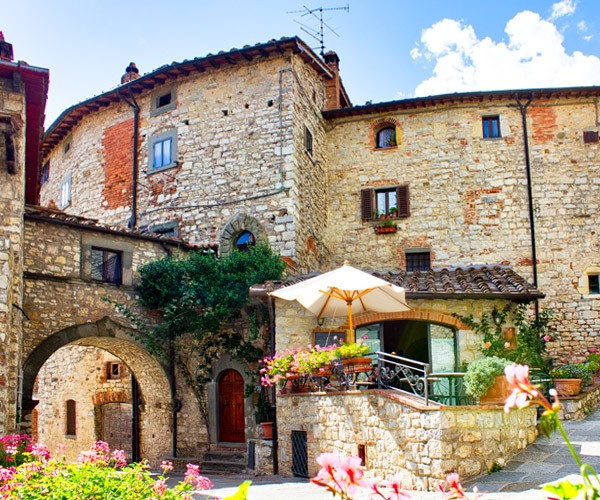 Chiusdino
In the title, I promised you a surprise at the end, and this is it: Chiusdino (pronounced kee-us-DEE-no). Why you ask? Read on. Chiusdino sits demurely atop a hill in the Province of Siena. This hilly little village is far from the tourist path, so it holds no popular shopping or tourist attractions. It is merely a warm and delicious local village, home to families that have lived there for centuries. Restaurants? You bet, and proud they are of their local cuisine. A stroll through the quiet streets will lead you to the city museum where you will find their ancient treasures and relics.
Chiusdino
In the title, I promised you a surprise at the end, and this is it: Chiusdino (pronounced kee-us-DEE-no). Why you ask? Read on. Chiusdino sits demurely atop a hill in the Province of Siena. This hilly little village is far from the tourist path, so it holds no popular shopping or tourist attractions. It is merely a warm and delicious local village, home to families that have lived there for centuries. Restaurants? You bet, and proud they are of their local cuisine. A stroll through the quiet streets will lead you to the city museum where you will find their ancient treasures and relics.
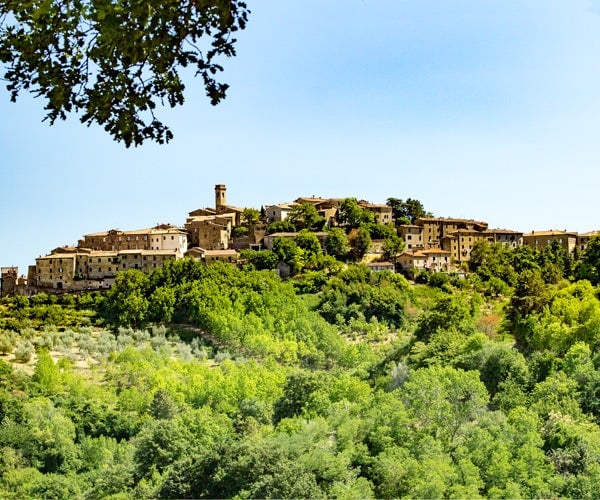 The town idolizes Saint Galgano, which begins the ‘surprise’ portion of this article. Within the walls of the town itself is the Rectory of St. Michael the Archangel. And within the Rectory is the reliquary which holds the head of Saint Galgano. So, who is this Galgano guy?
Galgano Guidotti was a 12th-century fellow that led a barbarous life. In his later years, he had a vision of the Archangel Michael promising to personally protect him. And on another occasion, his horse led him to a spot where, in another vision, he met the twelve Apostles and the Creator himself. It was in this spot, near Chiusdino, where he took hold of his sword and jammed it into a rock. Witnesses were known to have said that ‘…the stone yielded like butter.’ And it was here that he swore to give up his evil-doing and become Pious, which eventually led to his Sainthood.
The town idolizes Saint Galgano, which begins the ‘surprise’ portion of this article. Within the walls of the town itself is the Rectory of St. Michael the Archangel. And within the Rectory is the reliquary which holds the head of Saint Galgano. So, who is this Galgano guy?
Galgano Guidotti was a 12th-century fellow that led a barbarous life. In his later years, he had a vision of the Archangel Michael promising to personally protect him. And on another occasion, his horse led him to a spot where, in another vision, he met the twelve Apostles and the Creator himself. It was in this spot, near Chiusdino, where he took hold of his sword and jammed it into a rock. Witnesses were known to have said that ‘…the stone yielded like butter.’ And it was here that he swore to give up his evil-doing and become Pious, which eventually led to his Sainthood.
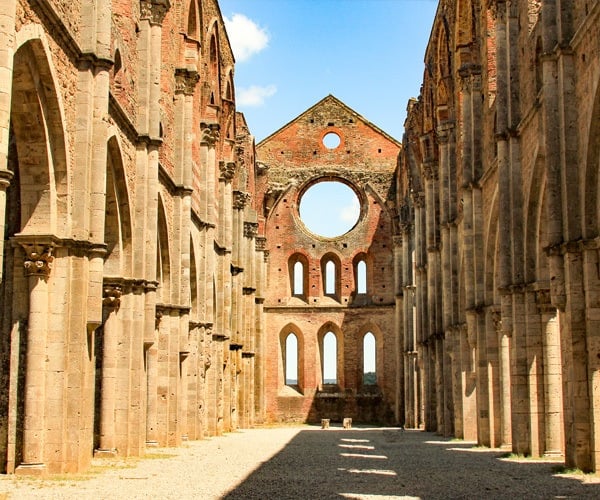 Since then, a fabulous Monastery was built that today is one of the most striking ancient sites you will see. Even though roofless, the San Galgano Monastery works so perfectly with the afternoon sun, that this would be an ideal place for a wedding. And right next door is the little round Abbey of San Galgano that was built around that Sword in the Stone. YES! This is the REAL original Sword in the Stone from the famous Legends of the Round Table. As it turns out, Galgano’s Italian sword was the inspiration for the English author, T.H. White, to pen the story stating that only a good guy, pure of heart, would be able to pull the sword from the stone.
Since then, a fabulous Monastery was built that today is one of the most striking ancient sites you will see. Even though roofless, the San Galgano Monastery works so perfectly with the afternoon sun, that this would be an ideal place for a wedding. And right next door is the little round Abbey of San Galgano that was built around that Sword in the Stone. YES! This is the REAL original Sword in the Stone from the famous Legends of the Round Table. As it turns out, Galgano’s Italian sword was the inspiration for the English author, T.H. White, to pen the story stating that only a good guy, pure of heart, would be able to pull the sword from the stone.
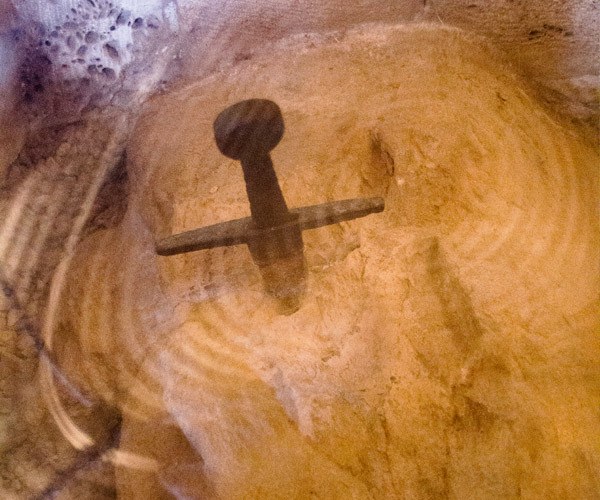 Surprise!
Patty Civalleri is the Owner of ItalyTravelBooks.com. ItalyTravelBooks.com represents books for the hungry traveller that regular guidebooks don’t feed.
If you would like to be a guest blogger on A Luxury Travel Blog in order to raise your profile, please contact us.
Surprise!
Patty Civalleri is the Owner of ItalyTravelBooks.com. ItalyTravelBooks.com represents books for the hungry traveller that regular guidebooks don’t feed.
If you would like to be a guest blogger on A Luxury Travel Blog in order to raise your profile, please contact us.Did you enjoy this article?
Receive similar content direct to your inbox.


I’ve heard so many good things about the beautiful city of Siena and I’m finally making plans to get there next year.
Until read this informative post I had never heard about the Palio, the horse race. When does it take place?
It would be great to see the race, there must be some fantastic photographic opportunities on offer to recreate the spirit of Siena in bygone times.